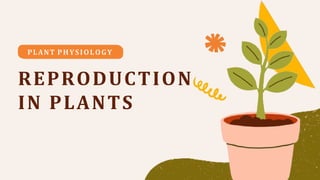
plant reproduction
- 2. Protects and nourishes the embryo it contains.
- 3. GYMNOSPERMS
- 4. GYMNOSPERMS The oldest surviving seed plants on Earth. Flourished and diversified about 250 million years ago, during the cold, Permian period. -Adapted to live in cold climates. Also called as the “evergreen trees”. Include one of the largest & the oldest organisms on Earth. The giant redwood tree, taller than 30 – story building, is one of the Earth’s largest organisms.
- 7. ANGIOSPERMS FERNS Flowering plants. Appeared on the Earth about 150 million years ago.
- 8. PARTS OF EMBRYO AND THEIR FUNCTION EPICOTYL - The part of the plant embryo above the cotyledon. - Includes most of what will become the stem and leaves of the plant. HYPOCOTYL - The area of the plant embryo below the cotyledon. - Includes what will become the roots of the plant. SEED COAT - Protects the embryo and its food supply. ENDOSPERM - Takes up most of the space. - A special food – storing tissue.
- 10. MONOCOTS DICOTS Angiosperms with only one cotyledon in their seeds. Angiosperms with two cotyledons in their seeds. In most monocots, food is stored as starch, a carbohydrate. In some dicots, the seed contains proteins and lipids. Example: corn, rice, wheat. Example: beans and peas.
- 13. The transfer of pollen from the male to the female part of a plant. POLLINATION
- 14. Pine Tree: is a typical gymnosperm. Takes 2 – 3 years from the time the cones form until seeds are released. FEMALE CONES MALE CONES Consist of spirally arranged scales and secrete a sticky resin. Smaller than female cones. Ovule: a structure, consisting of an egg inside protective cells, that develops into a seed. - Can be found at the base of each scale. Produces huge amount of pollen that are released in spring. Pollen grains have wing like structures that keep them aloft in the wind.
- 15. VASCULAR BUNDLES X Y L E M P H L O E M
- 17. An important organ because it is the reproductive structure of an angiosperm. Modified stems with leaves and other structures that are specialized for reproduction. Have 3 basic parts: male, female and sterile parts. - Male & female parts: produce male and female gametes. - Sterile parts: protect flowers and attract organisms that pollinate the flowers. FLOWER
- 18. THE STRUCTURE OF FLOWERS STIGMA Structure where pollen lands and germinates. Usually sticky so pollen grains stay on it. STYLE The part of the pistil that connects the stigma to the ovary. Pollen tube grows through the style. OVARY Contains ovules and develops into a fruit. Ovules form in the ovary and each ovule contains an egg. ANTHER The part of the stamen that produces pollen. Pollen grains contain sperm cells. FILAMENT The part of the stamen that holds up the anther.
- 19. COROLLA The name of the petals in a flower collectively. - The colorful petals of a rose are its corolla. PETALS Are usually the colorful, leaf like appendages at the top of a flower. FUNCTION: to attract pollinators. CALYX Name of the sepals. The tough, green covering on a rosebud is its calyx. SEPALS Are protective leaves at the base of a flower. Often green, cover the bud of a flower and protect the developing flower parts.
- 21. REPRODUCTIVE STRUCTURES PISTIL: the female, or egg – producing part of a flower. -Form at the center of the flower and usually have three (3) parts: stigma, style and ovary. STAMEN: the male, pollen – producing part of a flower. - Usually have two parts: anther and filament.
- 22. PERFECT OR IMPERFECT FLOWERS PERFECT FLOWERS: flowers that produce both male and female gametes in the same flower. IMPERFECT FLOWERS: flowers in which the male or female part is missing. -They are either male or female flowers.
- 25. ASEXUAL REPRODUCTION Involves no fertilization and produces offspring that are genetically identical to the parents. 1. Vegetative Reproduction 2. Artificial Propagation - Cutting - Grafting - Marcotting - Tissue culturing
- 26. Vegetative Reproduction The production of new plants from horizontal stems, plantlets or underground roots. Asexual reproduction that occurs naturally in plants. Plants that reproduce by vegetative reproduction can duplicate themselves very rapidly and crowd out other plants or organisms.
- 28. Occurs when humans use asexual methods to grow plants. Often faster than growing plants from seeds and produces a genetically identical crop. A by – product of a plant’s ability to regenerate lost parts. Methods of artificial propagation: cutting, grafting and tissue culturing. Artificial Propagation
- 29. C U T T I N G
- 30. GRAFTING: process wherein a piece of stem or bud is combined with another type of plant. Frequently used in soft stem vegetables to withstand heavy rain and wind. Form of regeneration. - SCION: the cut piece. - STOCK: the plant where the scion is attached; provides nutrition for it to grow.
- 31. M A R C O T T I N G MARCOTTING: the bark of a matured branch of a plant is removed and wrapped with soil, coconut husk or plastic. If supplied with water, roots will develop and can be cut to be planted and developed into a new plant.
- 32. TISSUE CULTURE TISSUE CULTURE: plants can be cultured or grown into a nutrient medium. The use of chemicals, plant hormones, and agar allows the growth of a piece of tissue from a plant. The tissue can be taken from young leaves, stem or root of the plant; tissue is placed in a container with a suitable liquid. The Bureau of Plant Industry culture sweet potato and banana for fast propagation and to ensure that the plants characteristics will not change.
- 33. THANK YOU